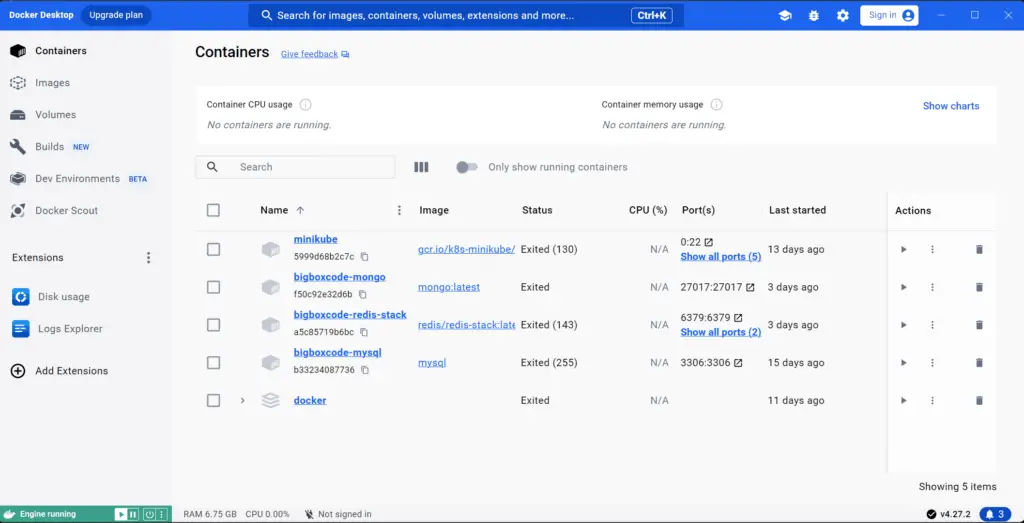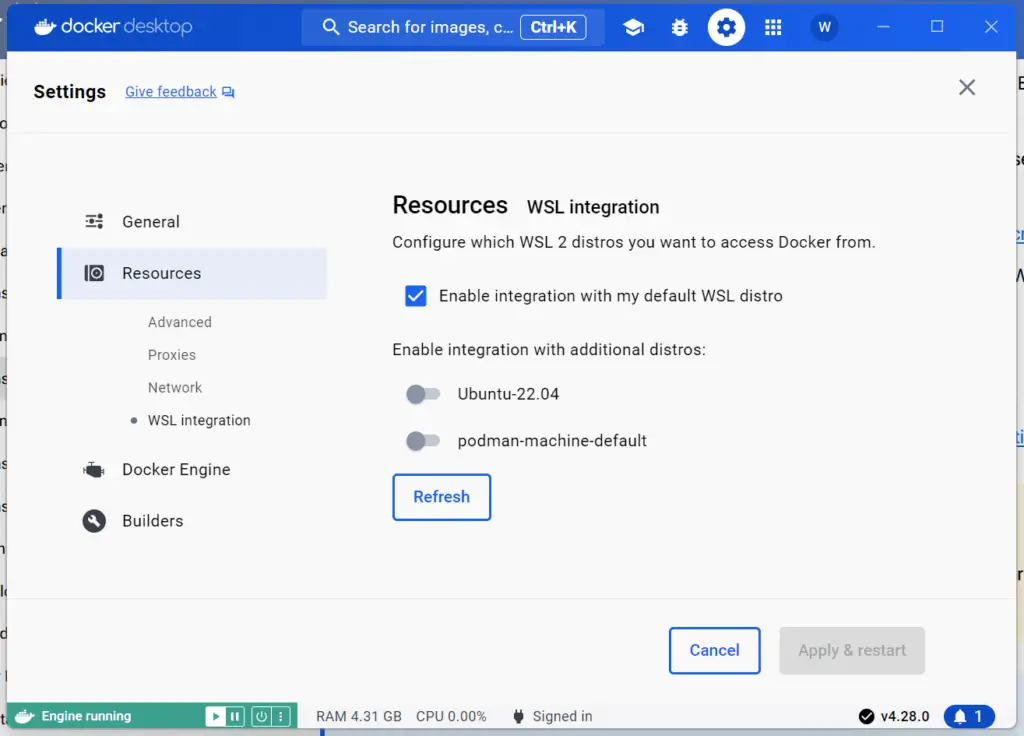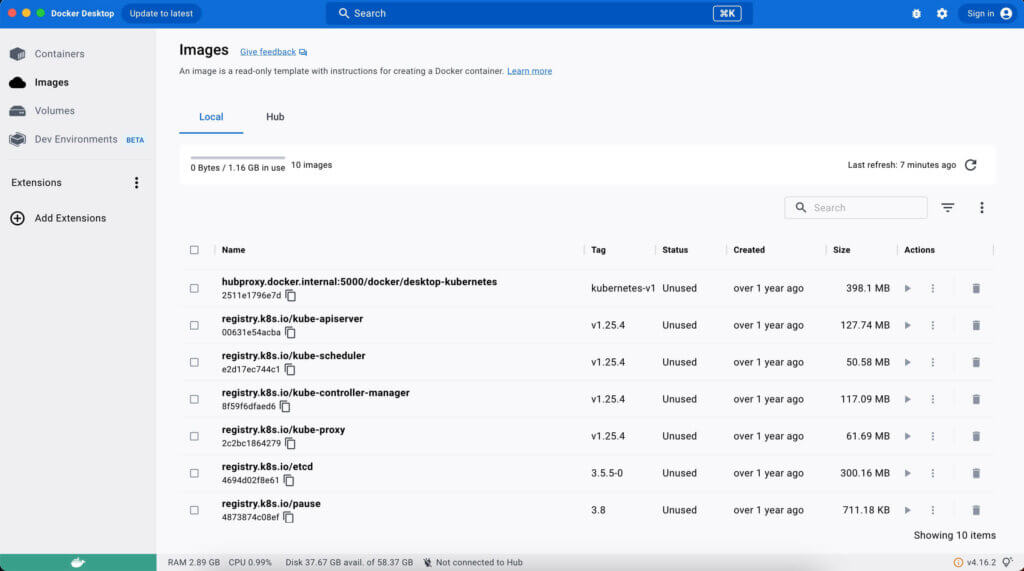Installing Docker is very easy. Whether on any desktop environment(like Windows, Linux, or macOS) or on a server environment, then installation is simple.
Here we are discussing the installation of docker on desktops and servers. We are discussing the installation process to the point so that you don’t have to go through a long document for the installation.
Docker Desktop
For using Docker in a desktop environment, there is “Docker Desktop” available. This is provided by Docker inc.
![]() NOTE
NOTE
Docker desktop is available for download from the link below-
Docker Desktop on Windows
On our Windows system, we are using the WSL(Windows Sub-System for Linux) for installing and using Docker.
After installation start the Docker Desktop application. It will look like the one below(we have a few containers running here).

![]() NOTES
NOTES
One important setting, that we should enable after installing the Docker Desktop on Windows is the “WSL integration“.
Go to the Settings > Resources > WSL integration
and check the “Enable integration with my default WSL distro“.
This will enable us to use the same docker system from the Linux Sub-system on Windows.

Docker Desktop on Linux
Docker Desktop on macOS

Docker Engine on Linux(Ubuntu) Server
Use the following steps to manage docker engine installation and management on your Ubuntu server-
Install Docker Engine on Linux(Ubuntu) Server
Let’s install the Docker engine on our Ubuntu server-
Step #1: Download the GPG key
Use the following command-
sudo apt-get update
sudo apt-get install ca-certificates curl
sudo install -m 0755 -d /etc/apt/keyrings
sudo curl -fsSL https://download.docker.com/linux/ubuntu/gpg -o /etc/apt/keyrings/docker.asc
sudo chmod a+r /etc/apt/keyrings/docker.ascHere are what the above commands do-
Step #2: Add Docker repository
Use the following command to add the docker repository to the Apt source list-
# Add the repository to Apt sources:
echo \
"deb [arch=$(dpkg --print-architecture) signed-by=/etc/apt/keyrings/docker.asc] https://download.docker.com/linux/ubuntu \
$(. /etc/os-release && echo "$VERSION_CODENAME") stable" | \
sudo tee /etc/apt/sources.list.d/docker.list > /dev/nullStep #3: Update Ubuntu package index
Update Ubuntu package indexes-
sudo apt-get updateStep #4: Install Docker and related packages
Use the following command to install docker and related packages-
sudo apt install docker-ce docker-ce-cli containerd.io docker-buildx-plugin docker-compose-pluginHere are the purposes of the above packages-
Step #5: Check docker
Check if docker is installed properly or not, by ckecking the docker version-
bigboxcode@ubuntu-server-1:~$ sudo docker version
Client: Docker Engine - Community
Version: 25.0.3
API version: 1.44
Go version: go1.21.6
Git commit: 4debf41
Built: Tue Feb 6 21:13:09 2024
OS/Arch: linux/amd64
Context: default
Server: Docker Engine - Community
Engine:
Version: 25.0.3
API version: 1.44 (minimum version 1.24)
Go version: go1.21.6
Git commit: f417435
Built: Tue Feb 6 21:13:09 2024
OS/Arch: linux/amd64
Experimental: false
containerd:
Version: 1.6.28
GitCommit: ae07eda36dd25f8a1b98dfbf587313b99c0190bb
runc:
Version: 1.1.12
GitCommit: v1.1.12-0-g51d5e94
docker-init:
Version: 0.19.0
GitCommit: de40ad0Check information of the docker installation-
bigboxcode@ubuntu-server-1:~$ sudo docker info
Client: Docker Engine - Community
Version: 25.0.3
Context: default
Debug Mode: false
Plugins:
buildx: Docker Buildx (Docker Inc.)
Version: v0.12.1
Path: /usr/libexec/docker/cli-plugins/docker-buildx
compose: Docker Compose (Docker Inc.)
Version: v2.24.6
Path: /usr/libexec/docker/cli-plugins/docker-compose
Server:
Containers: 1
Running: 0
Paused: 0
Stopped: 1
Images: 1
Server Version: 25.0.3
Storage Driver: overlay2
Backing Filesystem: extfs
Supports d_type: true
Using metacopy: false
Native Overlay Diff: true
userxattr: false
Logging Driver: json-file
Cgroup Driver: systemd
Cgroup Version: 2
Plugins:
Volume: local
Network: bridge host ipvlan macvlan null overlay
Log: awslogs fluentd gcplogs gelf journald json-file local splunk syslog
Swarm: inactive
Runtimes: io.containerd.runc.v2 runc
Default Runtime: runc
Init Binary: docker-init
containerd version: ae07eda36dd25f8a1b98dfbf587313b99c0190bb
runc version: v1.1.12-0-g51d5e94
init version: de40ad0
Security Options:
apparmor
seccomp
Profile: builtin
cgroupns
Kernel Version: 5.15.0-97-generic
Operating System: Ubuntu 22.04.4 LTS
OSType: linux
Architecture: x86_64
CPUs: 4
Total Memory: 1.917GiB
Name: ubuntu-server-1
ID: a78a1bfe-65a1-43eb-8d1f-98c8809b88be
Docker Root Dir: /var/lib/docker
Debug Mode: false
Experimental: false
Insecure Registries:
127.0.0.0/8
Live Restore Enabled: falseUninstall Docker Engine from Linux(Ubuntu) Server
Use the following command to remove the Docker engine and related packages from your Ubuntu server-
sudo apt purge docker-ce docker-ce-cli containerd.io docker-buildx-plugin docker-compose-plugin docker-ce-rootless-extras